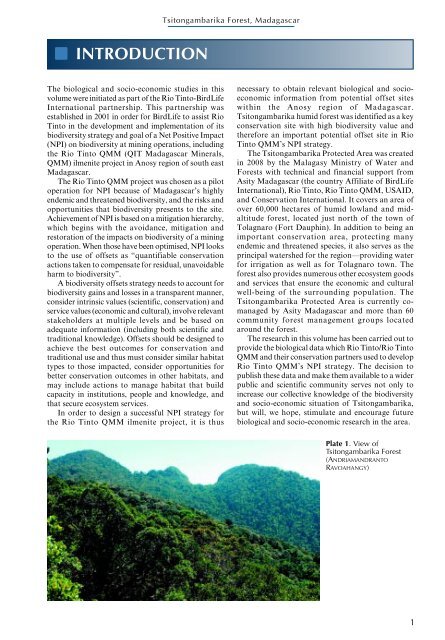TSITONGAMBARIKA FOREST, MADAGASCAR - BirdLife International
TSITONGAMBARIKA FOREST, MADAGASCAR - BirdLife International
TSITONGAMBARIKA FOREST, MADAGASCAR - BirdLife International
Create successful ePaper yourself
Turn your PDF publications into a flip-book with our unique Google optimized e-Paper software.
■ INTRODUCTION<br />
The biological and socio-economic studies in this<br />
volume were initiated as part of the Rio Tinto-<strong>BirdLife</strong><br />
<strong>International</strong> partnership. This partnership was<br />
established in 2001 in order for <strong>BirdLife</strong> to assist Rio<br />
Tinto in the development and implementation of its<br />
biodiversity strategy and goal of a Net Positive Impact<br />
(NPI) on biodiversity at mining operations, including<br />
the Rio Tinto QMM (QIT Madagascar Minerals,<br />
QMM) ilmenite project in Anosy region of south east<br />
Madagascar.<br />
The Rio Tinto QMM project was chosen as a pilot<br />
operation for NPI because of Madagascar’s highly<br />
endemic and threatened biodiversity, and the risks and<br />
opportunities that biodiversity presents to the site.<br />
Achievement of NPI is based on a mitigation hierarchy,<br />
which begins with the avoidance, mitigation and<br />
restoration of the impacts on biodiversity of a mining<br />
operation. When those have been optimised, NPI looks<br />
to the use of offsets as “quantifiable conservation<br />
actions taken to compensate for residual, unavoidable<br />
harm to biodiversity”.<br />
A biodiversity offsets strategy needs to account for<br />
biodiversity gains and losses in a transparent manner,<br />
consider intrinsic values (scientific, conservation) and<br />
service values (economic and cultural), involve relevant<br />
stakeholders at multiple levels and be based on<br />
adequate information (including both scientific and<br />
traditional knowledge). Offsets should be designed to<br />
achieve the best outcomes for conservation and<br />
traditional use and thus must consider similar habitat<br />
types to those impacted, consider opportunities for<br />
better conservation outcomes in other habitats, and<br />
may include actions to manage habitat that build<br />
capacity in institutions, people and knowledge, and<br />
that secure ecosystem services.<br />
In order to design a successful NPI strategy for<br />
the Rio Tinto QMM ilmenite project, it is thus<br />
Tsitongambarika Forest, Madagascar<br />
necessary to obtain relevant biological and socioeconomic<br />
information from potential offset sites<br />
within the Anosy region of Madagascar.<br />
Tsitongambarika humid forest was identified as a key<br />
conservation site with high biodiversity value and<br />
therefore an important potential offset site in Rio<br />
Tinto QMM’s NPI strategy.<br />
The Tsitongambarika Protected Area was created<br />
in 2008 by the Malagasy Ministry of Water and<br />
Forests with technical and financial support from<br />
Asity Madagascar (the country Affiliate of <strong>BirdLife</strong><br />
<strong>International</strong>), Rio Tinto, Rio Tinto QMM, USAID,<br />
and Conservation <strong>International</strong>. It covers an area of<br />
over 60,000 hectares of humid lowland and midaltitude<br />
forest, located just north of the town of<br />
Tolagnaro (Fort Dauphin). In addition to being an<br />
important conservation area, protecting many<br />
endemic and threatened species, it also serves as the<br />
principal watershed for the region—providing water<br />
for irrigation as well as for Tolagnaro town. The<br />
forest also provides numerous other ecosystem goods<br />
and services that ensure the economic and cultural<br />
well-being of the surrounding population. The<br />
Tsitongambarika Protected Area is currently comanaged<br />
by Asity Madagascar and more than 60<br />
community forest management groups located<br />
around the forest.<br />
The research in this volume has been carried out to<br />
provide the biological data which Rio Tinto/Rio Tinto<br />
QMM and their conservation partners used to develop<br />
Rio Tinto QMM’s NPI strategy. The decision to<br />
publish these data and make them available to a wider<br />
public and scientific community serves not only to<br />
increase our collective knowledge of the biodiversity<br />
and socio-economic situation of Tsitongambarika,<br />
but will, we hope, stimulate and encourage future<br />
biological and socio-economic research in the area.<br />
Plate 1. View of<br />
Tsitongambarika Forest<br />
(ANDRIAMANDRANTO<br />
RAVOAHANGY)<br />
1

















